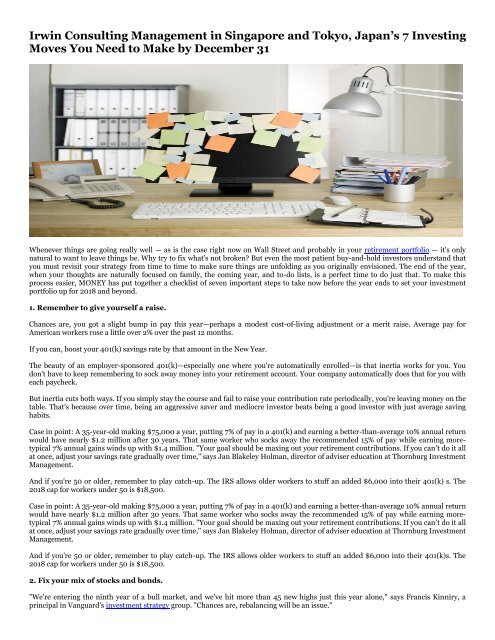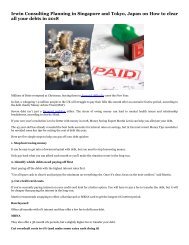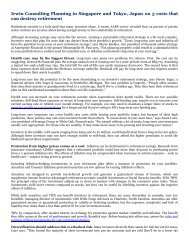Irwin Consulting Management in Singapore and Tokyo, Japan’s 7 Investing Moves You Need to Make by December 31
Whenever things are going really well — as is the case right now on Wall Street and probably in your retirement portfolio — it's only natural to want to leave things be.
Whenever things are going really well — as is the case right now on Wall Street and probably in your retirement portfolio — it's only natural to want to leave things be.
Create successful ePaper yourself
Turn your PDF publications into a flip-book with our unique Google optimized e-Paper software.
<strong>Irw<strong>in</strong></strong> <strong>Consult<strong>in</strong>g</strong> <strong>Management</strong> <strong>in</strong> S<strong>in</strong>gapore <strong>and</strong> <strong>Tokyo</strong>, <strong>Japan’s</strong> 7 Invest<strong>in</strong>g<br />
<strong>Moves</strong> <strong>You</strong> <strong>Need</strong> <strong>to</strong> <strong>Make</strong> <strong>by</strong> <strong>December</strong> <strong>31</strong><br />
Whenever th<strong>in</strong>gs are go<strong>in</strong>g really well — as is the case right now on Wall Street <strong>and</strong> probably <strong>in</strong> your retirement portfolio — it's only<br />
natural <strong>to</strong> want <strong>to</strong> leave th<strong>in</strong>gs be. Why try <strong>to</strong> fix what's not broken? But even the most patient buy-<strong>and</strong>-hold <strong>in</strong>ves<strong>to</strong>rs underst<strong>and</strong> that<br />
you must revisit your strategy from time <strong>to</strong> time <strong>to</strong> make sure th<strong>in</strong>gs are unfold<strong>in</strong>g as you orig<strong>in</strong>ally envisioned. The end of the year,<br />
when your thoughts are naturally focused on family, the com<strong>in</strong>g year, <strong>and</strong> <strong>to</strong>-do lists, is a perfect time <strong>to</strong> do just that. To make this<br />
process easier, MONEY has put <strong>to</strong>gether a checklist of seven important steps <strong>to</strong> take now before the year ends <strong>to</strong> set your <strong>in</strong>vestment<br />
portfolio up for 2018 <strong>and</strong> beyond.<br />
1. Remember <strong>to</strong> give yourself a raise.<br />
Chances are, you got a slight bump <strong>in</strong> pay this year—perhaps a modest cost-of-liv<strong>in</strong>g adjustment or a merit raise. Average pay for<br />
American workers rose a little over 2% over the past 12 months.<br />
If you can, boost your 401(k) sav<strong>in</strong>gs rate <strong>by</strong> that amount <strong>in</strong> the New Year.<br />
The beauty of an employer-sponsored 401(k)—especially one where you're au<strong>to</strong>matically enrolled—is that <strong>in</strong>ertia works for you. <strong>You</strong><br />
don't have <strong>to</strong> keep remember<strong>in</strong>g <strong>to</strong> sock away money <strong>in</strong><strong>to</strong> your retirement account. <strong>You</strong>r company au<strong>to</strong>matically does that for you with<br />
each paycheck.<br />
But <strong>in</strong>ertia cuts both ways. If you simply stay the course <strong>and</strong> fail <strong>to</strong> raise your contribution rate periodically, you're leav<strong>in</strong>g money on the<br />
table. That's because over time, be<strong>in</strong>g an aggressive saver <strong>and</strong> mediocre <strong>in</strong>ves<strong>to</strong>r beats be<strong>in</strong>g a good <strong>in</strong>ves<strong>to</strong>r with just average sav<strong>in</strong>g<br />
habits.<br />
Case <strong>in</strong> po<strong>in</strong>t: A 35-year-old mak<strong>in</strong>g $75,000 a year, putt<strong>in</strong>g 7% of pay <strong>in</strong> a 401(k) <strong>and</strong> earn<strong>in</strong>g a better-than-average 10% annual return<br />
would have nearly $1.2 million after 30 years. That same worker who socks away the recommended 15% of pay while earn<strong>in</strong>g moretypical<br />
7% annual ga<strong>in</strong>s w<strong>in</strong>ds up with $1.4 million. "<strong>You</strong>r goal should be max<strong>in</strong>g out your retirement contributions. If you can't do it all<br />
at once, adjust your sav<strong>in</strong>gs rate gradually over time," says Jan Blakeley Holman, direc<strong>to</strong>r of adviser education at Thornburg Investment<br />
<strong>Management</strong>.<br />
And if you're 50 or older, remember <strong>to</strong> play catch-up. The IRS allows older workers <strong>to</strong> stuff an added $6,000 <strong>in</strong><strong>to</strong> their 401(k) s. The<br />
2018 cap for workers under 50 is $18,500.<br />
Case <strong>in</strong> po<strong>in</strong>t: A 35-year-old mak<strong>in</strong>g $75,000 a year, putt<strong>in</strong>g 7% of pay <strong>in</strong> a 401(k) <strong>and</strong> earn<strong>in</strong>g a better-than-average 10% annual return<br />
would have nearly $1.2 million after 30 years. That same worker who socks away the recommended 15% of pay while earn<strong>in</strong>g moretypical<br />
7% annual ga<strong>in</strong>s w<strong>in</strong>ds up with $1.4 million. "<strong>You</strong>r goal should be max<strong>in</strong>g out your retirement contributions. If you can't do it all<br />
at once, adjust your sav<strong>in</strong>gs rate gradually over time," says Jan Blakeley Holman, direc<strong>to</strong>r of adviser education at Thornburg Investment<br />
<strong>Management</strong>.<br />
And if you're 50 or older, remember <strong>to</strong> play catch-up. The IRS allows older workers <strong>to</strong> stuff an added $6,000 <strong>in</strong><strong>to</strong> their 401(k)s. The<br />
2018 cap for workers under 50 is $18,500.<br />
2. Fix your mix of s<strong>to</strong>cks <strong>and</strong> bonds.<br />
"We're enter<strong>in</strong>g the n<strong>in</strong>th year of a bull market, <strong>and</strong> we've hit more than 45 new highs just this year alone," says Francis K<strong>in</strong>niry, a<br />
pr<strong>in</strong>cipal <strong>in</strong> Vanguard's <strong>in</strong>vestment strategy group. "Chances are, rebalanc<strong>in</strong>g will be an issue."
So take care of it now, <strong>to</strong> set your portfolio up for success <strong>in</strong> the com<strong>in</strong>g year.<br />
If you started out with a moderate 60% s<strong>to</strong>ck/40% bond portfolio five years ago—<strong>and</strong> neglected <strong>to</strong> rout<strong>in</strong>ely reset that mix back <strong>to</strong> your<br />
orig<strong>in</strong>al strategy—your portfolio would have drifted <strong>in</strong><strong>to</strong> a far more aggressive 75% equity/25% fixed-<strong>in</strong>come strategy. That may seem<br />
harmless, but <strong>in</strong> the event of a market downturn, hav<strong>in</strong>g 75% of your nest egg <strong>in</strong> s<strong>to</strong>cks will lead <strong>to</strong> far greater losses than a moderate<br />
60% equity stake.<br />
Research shows it actually makes little difference when you rebalance—at year-end, on your birthday, or whenever your allocation drifts<br />
slightly. So now is just as good a time any.<br />
But if you are resett<strong>in</strong>g your allocation, remember "that the best way <strong>to</strong> rebalance is the most tax-efficient way," says K<strong>in</strong>niry.<br />
Before you start sell<strong>in</strong>g your w<strong>in</strong>n<strong>in</strong>g <strong>in</strong>vestments—which will trigger a tax bill—start <strong>by</strong> redirect<strong>in</strong>g new contributions for the follow<strong>in</strong>g<br />
year <strong>in</strong><strong>to</strong> lagg<strong>in</strong>g <strong>in</strong>vestments. In other words, s<strong>in</strong>ce your s<strong>to</strong>cks have been outperform<strong>in</strong>g your bonds <strong>by</strong> a wide marg<strong>in</strong>, use most of<br />
your new contributions <strong>to</strong> pad your fixed-<strong>in</strong>come exposure. Also, rather than re<strong>in</strong>vest<strong>in</strong>g dividends <strong>and</strong> ga<strong>in</strong>s back <strong>in</strong><strong>to</strong> the same funds;<br />
use those distributions <strong>to</strong> add <strong>to</strong> your weakest-perform<strong>in</strong>g asset class.<br />
3. Maximize your other tax shelters.<br />
As you "<strong>to</strong>p off" the contributions you're mak<strong>in</strong>g <strong>to</strong> your 401(k), don't forget <strong>to</strong> fund all your other tax-sheltered <strong>in</strong>vestment accounts<br />
that often get overlooked.<br />
Start with your IRAs. While most Americans with <strong>in</strong>come have access <strong>to</strong> at least one type of <strong>in</strong>dividual retirement account—a traditional<br />
IRA, a Roth, a spousal IRA, or even a nondeductible account—only 33% of Americans currently contribute <strong>to</strong> these accounts. <strong>You</strong> can<br />
save up <strong>to</strong> $5,500 <strong>in</strong> 2018 or $6,500 if you're 50 or older.<br />
Though you have until April 15, 2019, <strong>to</strong> make your 2018 IRA contribution, don't delay. By immediately contribut<strong>in</strong>g when you're<br />
eligible on Jan. 1, you'll maximize the impact of that tax-deferral.<br />
In addition <strong>to</strong> IRAs, don't overlook health sav<strong>in</strong>gs accounts. "HSAs are k<strong>in</strong>d of a stealth retirement sav<strong>in</strong>gs vehicle," says Rob Williams,<br />
direc<strong>to</strong>r of <strong>in</strong>come plann<strong>in</strong>g for the Schwab Center for F<strong>in</strong>ancial Research. That's because HSAs are triple tax advantaged: Money goes<br />
<strong>in</strong> tax deferred, grows tax sheltered, <strong>and</strong>, if withdrawn for qualified medical expenses, comes out tax-free.<br />
<strong>You</strong>'re likely <strong>to</strong> have plenty of those costs <strong>in</strong> retirement, which, if not addressed, can eat <strong>in</strong><strong>to</strong> your nest egg. A recent Fidelity analysis<br />
found that a typical 65-year-old couple retir<strong>in</strong>g this year can expect <strong>to</strong> spend $275,000 <strong>in</strong> health-related expenses throughout the course<br />
of their retirement.<br />
To qualify, you have <strong>to</strong> be covered <strong>by</strong> a high-deductible health plan. In 2018 the maximum contribution for an eligible <strong>in</strong>dividual is<br />
$3,450. For families, it's $6,900. As with other tax-deferred accounts, it's important <strong>to</strong> max out if you can, yet only 15% of HSA users<br />
actually do.<br />
4. <strong>Make</strong> sure your hatches are battened down.<br />
Diversification serves many purposes. In addition <strong>to</strong> ensur<strong>in</strong>g that some of your money is held <strong>in</strong> assets that outperform when times are<br />
good, you're also mak<strong>in</strong>g sure that you have some exposure at all times <strong>to</strong> <strong>in</strong>vestments that are likely <strong>to</strong> hold up <strong>in</strong> a market s<strong>to</strong>rm.<br />
But how sure are you that you have enough defensive <strong>in</strong>vestments head<strong>in</strong>g <strong>in</strong><strong>to</strong> the New Year?<br />
"Everyone should look at their accounts now <strong>and</strong> make sure they have some ballast," says f<strong>in</strong>ancial planner Lewis Altfest.<br />
What steps should you take? After a spectacular year for equities <strong>in</strong> 2017—with the Dow Jones <strong>in</strong>dustrial average up more than 20%—<br />
now's the time <strong>to</strong> "trim some of the high-fly<strong>in</strong>g s<strong>to</strong>cks with high P/Es," he says, referr<strong>in</strong>g <strong>to</strong> companies sport<strong>in</strong>g lofty price/earn<strong>in</strong>gs<br />
ratios. That's because <strong>in</strong> a market downturn, s<strong>to</strong>cks with high P/E ratios tend <strong>to</strong> fall more.<br />
Altfest says you can replace those hold<strong>in</strong>gs with exposure <strong>to</strong> defensive s<strong>to</strong>cks, such as shares of consumer-staples companies that make<br />
th<strong>in</strong>gs people need, not want, like <strong>to</strong>othpaste <strong>and</strong> soap. <strong>You</strong> can also look <strong>to</strong> economically <strong>in</strong>sensitive companies such as drug makers<br />
that aren't reliant on a robust economy <strong>to</strong> thrive.<br />
And if you're worried about market turmoil <strong>in</strong> the com<strong>in</strong>g year, now is a good time <strong>to</strong> trim some of your hold<strong>in</strong>gs <strong>in</strong> non-<strong>in</strong>vestmentgrade<br />
"junk" bonds. This is debt issued <strong>by</strong> companies with less-than-prist<strong>in</strong>e balance sheets <strong>and</strong> f<strong>in</strong>ancials.<br />
Because of that risk, junk bonds have his<strong>to</strong>rically acted more like s<strong>to</strong>cks than bonds. In 2008, for <strong>in</strong>stance, the typical junk-bond fund<br />
lost nearly 30% of its value, accord<strong>in</strong>g <strong>to</strong> Morn<strong>in</strong>gstar, which was on par with the 37% decl<strong>in</strong>e for the S&P 500 <strong>in</strong>dex of blue-chip s<strong>to</strong>cks.<br />
5. <strong>Make</strong> your wish list.<br />
If the goal of <strong>in</strong>vest<strong>in</strong>g is <strong>to</strong> buy low <strong>and</strong> sell high, at some po<strong>in</strong>t you have <strong>to</strong> commit <strong>to</strong> <strong>in</strong>vest<strong>in</strong>g <strong>in</strong> assets that are beaten down or<br />
unloved. Alas, after nearly n<strong>in</strong>e years of rally<strong>in</strong>g, s<strong>to</strong>cks are pretty expensive across the board.
But just as you put <strong>to</strong>gether a Christmas shopp<strong>in</strong>g list well before the holidays, <strong>in</strong>ves<strong>to</strong>rs ought <strong>to</strong> list the s<strong>to</strong>cks they'd like <strong>to</strong> own before<br />
the next downturn comes around so they'll know what <strong>to</strong> buy once the price is right. Among highly profitable companies that will trade<br />
at s<strong>in</strong>gle-digit price/earn<strong>in</strong>gs ratios if their shares fall <strong>by</strong> a third (which is typical <strong>in</strong> a bear market): Apple (ticker: AAPL), Intel (INTC),<br />
HP (HPQ), <strong>and</strong> Applied Materials (AMAT).<br />
Meanwhile, as you wait for buy<strong>in</strong>g opportunities <strong>to</strong> open up after a downturn, you can start putt<strong>in</strong>g new money <strong>to</strong> work now <strong>in</strong> the one<br />
place that's relatively cheap: foreign s<strong>to</strong>cks.<br />
"We have a significant position—40% if you X-ray our funds—<strong>in</strong> <strong>in</strong>ternational securities," says Altfest. "They're all cheaper than the<br />
U.S.," he says, add<strong>in</strong>g that not only is Europe grow<strong>in</strong>g faster than the U.S. now, many foreign economies, <strong>in</strong>clud<strong>in</strong>g the emerg<strong>in</strong>g<br />
markets, aren't as far along <strong>in</strong> their recoveries as is America.<br />
In our MONEY 50 recommended list, you can go with Vanguard Total International S<strong>to</strong>ck Index (VGTSX) for broad exposure or T.<br />
Rowe Price Emerg<strong>in</strong>g Markets S<strong>to</strong>ck (PRMSX), focus<strong>in</strong>g on the fast-grow<strong>in</strong>g emerg<strong>in</strong>g markets, which trade at a P/E ratio half that of<br />
the U.S.<br />
6. Harvest your tax losses.<br />
Admit it: <strong>You</strong> hate it when the government takes a cut of your profits every time you sell any <strong>in</strong>vestment that has gone up <strong>in</strong> price. But<br />
you can get Uncle Sam back <strong>by</strong> mak<strong>in</strong>g him share your pa<strong>in</strong> when you sell <strong>in</strong>vestments that have lost value. It's called tax-loss<br />
harvest<strong>in</strong>g, <strong>and</strong> "now's the time <strong>to</strong> be look<strong>in</strong>g at that strategically," says Schwab's Williams.<br />
Isn't sell<strong>in</strong>g at a loss admitt<strong>in</strong>g defeat? It doesn't have <strong>to</strong> be. When you sell a s<strong>to</strong>ck or fund at a loss, you are realiz<strong>in</strong>g the loss for tax<br />
purposes. And you can use that loss <strong>to</strong> reduce your taxes—<strong>by</strong> offsett<strong>in</strong>g ga<strong>in</strong>s elsewhere <strong>in</strong> your portfolio or reduc<strong>in</strong>g ord<strong>in</strong>ary <strong>in</strong>come<br />
up <strong>to</strong> $3,000.<br />
But you can turn around <strong>and</strong> re<strong>in</strong>vest <strong>in</strong> the same type of asset, as long as it's not "substantially identical." Or wait 30 days <strong>and</strong> step<br />
back <strong>in</strong><strong>to</strong> the exact same <strong>in</strong>vestment.<br />
7. Check your au<strong>to</strong>mated sett<strong>in</strong>gs.<br />
When <strong>in</strong> doubt, put it on au<strong>to</strong>pilot. In most situations, that's wise f<strong>in</strong>ancial advice. "There's a huge benefit <strong>to</strong> hav<strong>in</strong>g your accounts<br />
au<strong>to</strong>mated, so that contributions are au<strong>to</strong>matically deducted <strong>in</strong><strong>to</strong> your 401(k) <strong>and</strong> <strong>in</strong>vested for you without requir<strong>in</strong>g you <strong>to</strong> th<strong>in</strong>k about<br />
it," says Holman.<br />
It goes well beyond putt<strong>in</strong>g money <strong>in</strong><strong>to</strong> a 401(k), though. Au<strong>to</strong>mation now allows for sav<strong>in</strong>gs rates <strong>to</strong> be <strong>in</strong>creased over time, or for your<br />
portfolio <strong>to</strong> be rebalanced at periodic <strong>in</strong>tervals, or even for tax losses <strong>to</strong> be realized.<br />
Still, "you need <strong>to</strong> check on your au<strong>to</strong>pilots annually <strong>to</strong> see what's be<strong>in</strong>g deducted <strong>and</strong> how it's be<strong>in</strong>g <strong>in</strong>vested," says Holman.<br />
Start <strong>by</strong> mak<strong>in</strong>g sure your 401(k) contribution <strong>in</strong>creases aren't <strong>to</strong>o conservative. Many plans allow for sav<strong>in</strong>gs rates <strong>to</strong> rise <strong>by</strong> one or two<br />
percentage po<strong>in</strong>ts a year. If you can afford more, override the au<strong>to</strong>pilot <strong>to</strong> put your portfolio on a faster path. Also, make sure the s<strong>to</strong>ck<strong>and</strong>-bond<br />
mix that you are be<strong>in</strong>g au<strong>to</strong>matically rebalanced <strong>in</strong><strong>to</strong> is still appropriate for you. Chances are, you set up your allocation<br />
strategy several years ago <strong>and</strong> may have forgotten about it. But as the end of the year should rem<strong>in</strong>d you, time marches on quickly. And<br />
th<strong>in</strong>gs change.





